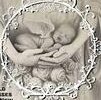When Tess Soholt stumbled upon an old wedding dress at a thrift store, it wasn’t the usual purchase she would make. But the 71-year-old Minnesota grandmother saw something more: “a symbol of joy for a life that never began.” Soholt is one of many volunteer seamstresses around the country who sew tiny handmade gowns, called angel gowns, to bring dignity to infants who die during pregnancy or at birth. The gowns, which are made from donated dresses, help families remember their lost loved ones.
The gowns are distributed free of charge to hospitals and families. And for Soholt and other seamstresses, the work is a labor of love, often with profound personal significance. “If I can help a family in their time of grief and loss, then that is what I want to do,” she says.
Soholt, a retired labor and delivery nurse, was inspired to start her own angel gown program after reading about one in a Huffington Post article. It touched a chord with her, as she had lost a baby in the NICU after her first delivery. She also recalled her own mother’s grief over her stillborn daughter. “As a mother, you just feel so broken and empty,” she said. “The loss of a child is always so hard, and it’s even harder when you don’t get to celebrate the little milestones like their birthday or their first Christmas.”
Soholt started her own nonprofit, Angel Gowns of South Bay, and enlisted others in her church to help. Now, more than 20 seamstresses from San Pedro to Redondo Beach are helping her fill the request for gowns. The organization donates the outfits to hospitals in the area and across the country, including Dignity Health – St. Mary’s Medical Center Long Beach in California, where a state-of-the-art 53-bed level 3 NICU cares for babies from Pomona Valley and beyond.
Often, a gown can be the first and last outfit an infant wears before they are cremated or buried. That makes the outfits all the more meaningful for families, said NICU Helping Hands Founder and Executive Director Lisa Grubbs. “When families receive these gowns, it’s really an honor to be a part of their journey,” she said.
For seamstresses, making the garments is also therapeutic. “Many of these women have had a personal experience with loss,” Grubbs said. “For some, this is the first time they’ve ever sat down to do this kind of sewing. It’s very healing.”
Each outfit takes about a week to complete. And though the gowns are meant for newborns, they also serve as a keepsake for older siblings and adults who have experienced a similar loss. “It’s important for them to have that reminder, especially if the loss is recent,” Grubbs said.
So far, the organization has donated more than 1,600 angel gowns. And that number is growing. A man in Puyallup recently contacted the group after seeing the column. His wife had died, and he wanted to donate her wedding dress so that it could be turned into an angel gown for another family.
